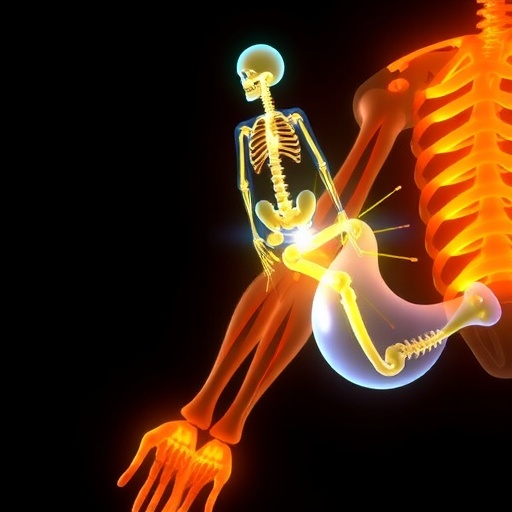In a groundbreaking advancement within the field of bone biology and regenerative medicine, researchers at the University of Birmingham, U.K., have unveiled pivotal insights into the multifunctional roles of the bioactive peptide PEPITEM and its associated pharmacophores. This molecule, originally identified in 2015, has been extensively investigated for its immune-regulatory properties; however, the latest findings catapult its potential as a formidable therapeutic candidate against osteoporosis and related bone disorders. Through meticulous experimental studies involving cellular assays, tissue cultures, and animal models, the research collective has demonstrated that the full-length PEPITEM molecule exerts a sophisticated orchestration of bone remodeling processes, exhibiting dual anabolic and anti-catabolic actions crucial for restoring skeletal integrity.
The nuanced pathophysiology of osteoporosis is characterized by an imbalance between osteoblast-driven bone formation and osteoclast-mediated bone resorption, culminating in diminished bone density and microarchitectural deterioration. Current pharmacotherapies often target singular pathways with limited efficacy and notable side effects. Against this backdrop, the Birmingham team’s elucidation of PEPITEM’s biological activity offers a novel paradigm. Their investigations revealed that distinct peptide sequences derived from either terminus of the PEPITEM molecule distinctly influence bone cell populations. Specifically, short tripeptide fragments modulate the maturation of osteoblasts and suppress osteoclast differentiation via secreted inhibitory proteins, whereas the intact molecule integrates these effects to deliver a comprehensive enhancement in bone tissue regeneration.
Experimental strategies employed included advanced bone organoid cultures, which faithfully recapitulate the complex microenvironment of human bone, allowing analysis of cellular interplay under controlled conditions. These organoid assays affirmed that the tripeptide pharmacophores regulate osteoblastic lineage progression and concurrently induce secretion of osteoclastogenesis-inhibitory factors. However, in vivo evaluations using robust animal models of osteoporosis underscored that only the full-length PEPITEM molecule could elicit significant improvements in bone density and architectural parameters. This dichotomy underscores the importance of the entire molecular structure in harnessing synergistic mechanisms to counteract osteoporosis pathology effectively.
A striking revelation from the study pertains to vascular remodeling within bone tissue. PEPITEM and its derivatives were observed to significantly promote angiogenesis, particularly enhancing vascularization within the trabecular bone compartment—a key determinant of mechanical strength and resistance to fracture. The trabecular network, with its intricate honeycomb-like microstructure, relies on a dense capillary supply to sustain osteogenesis and nutrient exchange. Of particular interest is the increase in Type-H capillaries, specialized endothelial vessels instrumental in coupling angiogenesis with osteogenesis. Proximity analyses indicated that these capillaries are localized near osteoblasts expressing NCAM-1, the neuronal cell adhesion molecule identified as the receptor mediating PEPITEM’s osteogenic signals, thereby illuminating a previously uncharted molecular axis in bone vascular biology.
The therapeutic potential of PEPITEM extends beyond its bone anabolic action. By simultaneously inhibiting osteoclast activity—cells responsible for bone matrix degradation—the molecule addresses the pathological excess of catabolism prevalent in osteoporotic conditions. This bifunctional approach furnishes distinct advantages over existing monotherapy regimens, which often fail to adequately restore bone balance or preserve vascular integrity. Furthermore, the immunomodulatory background of PEPITEM intimates additional benefits in mitigating inflammation-driven bone loss, a characteristic feature in secondary osteoporosis associated with autoimmune diseases.
The investigative team, led by Professor Helen McGettrick and Dr. Amy Naylor, with contributions from Dr. Kathryn Frost of the University of Birmingham’s Department of Inflammation and Ageing, and Dr. James Edwards from the University of Oxford, harnessed cutting-edge molecular biology tools to dissect the mechanistic pathways underpinning PEPITEM’s effects. Their work delineates intricate signaling cascades involving cellular receptors, downstream transcription factors, and secretory proteins that converge to regulate bone remodeling and angiogenesis synergistically. Such comprehensive mechanistic insights pave the way for rational drug design and optimization of peptide-based therapeutics targeting multifaceted degenerative bone diseases.
PEPITEM’s journey from discovery to therapeutic candidacy is bolstered by ongoing patent activities, emphasizing its novel use in treating inflammation, immune-mediated disorders, and metabolic bone diseases. The multi-institutional collaboration benefits from robust funding support, including grants from the UK Medical Research Council and Versus Arthritis, underscoring the molecule’s high translational value. As the research community gears toward clinical application, concerted efforts are underway to identify industrial partnerships for advancing PEPITEM from preclinical stages to human trials.
The implication of bone vascularization enhancement by PEPITEM introduces a compelling avenue for future exploration. Angiogenesis is not only vital for skeletal health but also essential for facilitating the engraftment and survival of transplanted cells in regenerative therapies. By elucidating how PEPITEM modulates endothelial-osteoblastic interactions via NCAM-1, the study provides a strategic framework for developing combinational treatments that integrate vascular and skeletal regeneration. This holistic approach could revolutionize osteoporosis management, shifting the paradigm from symptom alleviation to tissue restoration.
In conclusion, the University of Birmingham’s landmark research presents PEPITEM as a multifaceted peptide with robust anabolic, anti-catabolic, and pro-angiogenic properties that collectively foster bone health and resilience. Such innovative findings enrich the scientific understanding of bone biology and open new therapeutic vistas for debilitating conditions such as osteoporosis. The promise of PEPITEM lies not only in its demonstrated biological efficacy but also in its potential to redefine the therapeutic landscape with precision medicines that mirror the complexity of bone remodeling processes. As this research evolves, it is poised to significantly influence both clinical practice and the broader field of regenerative medicine.
Subject of Research: Animals
Article Title: PEPITEM and its tripeptide pharmacophores: Mechanisms of bone regulation and therapeutic potential in health and disease
News Publication Date: 28-Aug-2025
Web References: https://doi.org/10.1016/j.biopha.2025.118489
Keywords: Bone diseases




